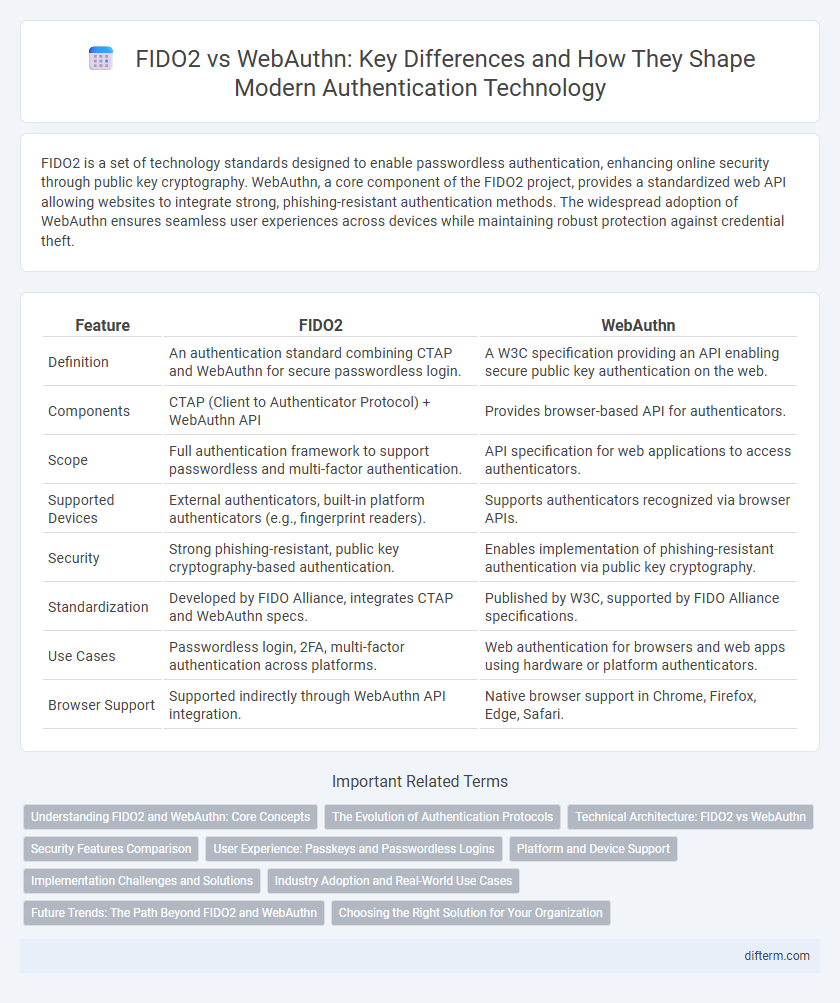FIDO2 is a set of technology standards designed to enable passwordless authentication, enhancing online security through public key cryptography. WebAuthn, a core component of the FIDO2 project, provides a standardized web API allowing websites to integrate strong, phishing-resistant authentication methods. The widespread adoption of WebAuthn ensures seamless user experiences across devices while maintaining robust protection against credential theft.
Table of Comparison
| Feature | FIDO2 | WebAuthn |
|---|---|---|
| Definition | An authentication standard combining CTAP and WebAuthn for secure passwordless login. | A W3C specification providing an API enabling secure public key authentication on the web. |
| Components | CTAP (Client to Authenticator Protocol) + WebAuthn API | Provides browser-based API for authenticators. |
| Scope | Full authentication framework to support passwordless and multi-factor authentication. | API specification for web applications to access authenticators. |
| Supported Devices | External authenticators, built-in platform authenticators (e.g., fingerprint readers). | Supports authenticators recognized via browser APIs. |
| Security | Strong phishing-resistant, public key cryptography-based authentication. | Enables implementation of phishing-resistant authentication via public key cryptography. |
| Standardization | Developed by FIDO Alliance, integrates CTAP and WebAuthn specs. | Published by W3C, supported by FIDO Alliance specifications. |
| Use Cases | Passwordless login, 2FA, multi-factor authentication across platforms. | Web authentication for browsers and web apps using hardware or platform authenticators. |
| Browser Support | Supported indirectly through WebAuthn API integration. | Native browser support in Chrome, Firefox, Edge, Safari. |
Understanding FIDO2 and WebAuthn: Core Concepts
FIDO2 is an open authentication standard developed by the FIDO Alliance that enables passwordless, phishing-resistant login experiences using public key cryptography. WebAuthn, a core component of the FIDO2 project, serves as a web API standard defined by the W3C, allowing browsers and servers to integrate strong authentication methods like biometrics or security keys. Understanding these concepts reveals how FIDO2 combines WebAuthn and the Client to Authenticator Protocol (CTAP) to deliver seamless, secure user authentication across web applications.
The Evolution of Authentication Protocols
FIDO2 represents the latest advancement in authentication protocols, building on the foundation established by WebAuthn to enhance passwordless security standards. WebAuthn, developed by the W3C in collaboration with the FIDO Alliance, enables secure public key-based authentication via browsers and devices. The evolution from WebAuthn to FIDO2 integrates client-to-authenticator protocols like CTAP2, broadening compatibility and usability across diverse platforms and devices.
Technical Architecture: FIDO2 vs WebAuthn
FIDO2 is a comprehensive authentication standard comprising WebAuthn and CTAP (Client to Authenticator Protocol), enabling passwordless security through public key cryptography. WebAuthn, standardized by W3C, functions as the browser API facilitating communication between web applications and authenticators, supporting key pair creation and assertion generation. The technical architecture of FIDO2 integrates WebAuthn for browser interactions and CTAP for external authenticators, ensuring secure, scalable, and phishing-resistant user authentication.
Security Features Comparison
FIDO2 and WebAuthn both enhance authentication security by eliminating passwords, using public key cryptography to prevent phishing and replay attacks. FIDO2 encompasses the Client to Authenticator Protocol (CTAP) alongside WebAuthn, enabling passwordless login with external authenticators like security keys, while WebAuthn is the web API standard facilitating server-client communication for these credentials. Security features of FIDO2 include biometric verification, device binding, and phishing-resistant authentication, whereas WebAuthn's strengths lie in its broad browser support and seamless integration with existing web authentication systems.
User Experience: Passkeys and Passwordless Logins
FIDO2 and WebAuthn significantly enhance user experience by enabling passkeys and seamless passwordless logins, which reduce reliance on traditional passwords prone to phishing attacks. WebAuthn, a core component of FIDO2, standardizes cryptographic authentication methods across browsers and devices, ensuring interoperability and strong security for users. This passwordless approach streamlines login processes, accelerates access, and improves user satisfaction by minimizing friction and boosting security simultaneously.
Platform and Device Support
FIDO2 and WebAuthn are key standards in passwordless authentication, with WebAuthn serving as the Web Authentication API implementation of the FIDO2 project. Platform support for FIDO2 spans major operating systems like Windows 10, macOS, Android, and iOS, enabling native integration for biometric and hardware security keys. Device compatibility varies, with broad support for USB, NFC, and Bluetooth security keys, ensuring flexible authentication options across desktops, laptops, and mobile devices.
Implementation Challenges and Solutions
FIDO2 implementation challenges primarily involve ensuring seamless integration with existing authentication systems and addressing device compatibility across diverse platforms. WebAuthn, as the client-side API standard within FIDO2, requires developers to handle complex cryptographic operations and user verification procedures, often necessitating extensive testing for browser support and secure credential storage. Solutions include leveraging comprehensive developer libraries, deploying fallback authentication methods, and adopting standardized Public Key Infrastructure (PKI) practices to enhance interoperability and user experience.
Industry Adoption and Real-World Use Cases
FIDO2 and WebAuthn have gained widespread industry adoption, with major tech companies like Microsoft, Google, and Apple integrating these standards into their authentication frameworks. WebAuthn, as a core component of FIDO2, enables secure, passwordless login experiences across browsers and platforms, driving real-world use cases in enterprise security, online banking, and consumer applications. The collaboration between the FIDO Alliance and the W3C ensures continuous evolution, promoting interoperability and enhancing user convenience in authentication processes worldwide.
Future Trends: The Path Beyond FIDO2 and WebAuthn
Emerging authentication protocols leverage advancements in biometric verification and decentralized identity frameworks to enhance security beyond FIDO2 and WebAuthn standards. Integration with artificial intelligence for adaptive authentication and the expansion of passwordless ecosystems are driving next-generation identity solutions. These innovations aim to create seamless, privacy-centric user experiences while maintaining robust protection against evolving cyber threats.
Choosing the Right Solution for Your Organization
FIDO2 and WebAuthn both enhance cybersecurity by offering passwordless authentication; selecting the right solution depends on your organization's infrastructure and user base compatibility. FIDO2 provides a comprehensive framework including CTAP and WebAuthn protocols, ideal for organizations seeking broad device interoperability and enhanced security. WebAuthn, as the web API component, is essential for integrating secure authentication into web applications, making it vital for organizations focused on web-native environments.
FIDO2 vs WebAuthn Infographic

 difterm.com
difterm.com